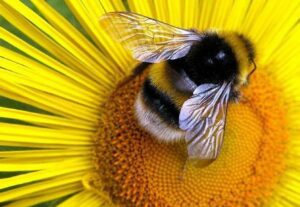 It is a commonly known fact that you can thank a pollinator for one out of three bites of food you eat. We understand that we need pollinators. We hope for them to create our wonderful bounty of edible crops. We wait for them. We worry about if and when they will come. The service that pollinators provide is part of a mutually beneficial symbiotic relationship with plants. The bee ensures plant species’ survival by moving around the male pollen to the female flower. In exchange, the bee receives nectar and/or pollen to ensure its own survival. The pollinator doesn’t know that it is helping the plant and the plant doesn’t know that it is helping the pollinator. Each species is oblivious to the other and is only concerned about its own needs.
It is a commonly known fact that you can thank a pollinator for one out of three bites of food you eat. We understand that we need pollinators. We hope for them to create our wonderful bounty of edible crops. We wait for them. We worry about if and when they will come. The service that pollinators provide is part of a mutually beneficial symbiotic relationship with plants. The bee ensures plant species’ survival by moving around the male pollen to the female flower. In exchange, the bee receives nectar and/or pollen to ensure its own survival. The pollinator doesn’t know that it is helping the plant and the plant doesn’t know that it is helping the pollinator. Each species is oblivious to the other and is only concerned about its own needs.
In this respect, maybe it comes naturally to humans to be focused on our own needs and oblivious to the needs of the rest of nature. But we do so at our own peril. Since one-third of our food crops are dependent on pollinators then it is the least that we can do to give them one-third of our growing space for their food and shelter.
For example, if your garden is 100 square feet in size, plants rich in pollen and nectar should cover at least 33 square feet. If your garden is 1000 square feet pollinator plants should cover 330 square feet. If the total of your front and back yard is 5,000 square feet than a minimum of 1,650 square feet should be planted in pollinator plants.
The honeybee is the poster child for pollinators, but there are many other pollinators. There are 4,000 species of native bees in North America alone. Other pollinators of flowering plants include butterflies, beetles, flies, moths, and other insects. By extension, many other insects provide pest control for our food crops helping them to grow to maturity without being decimated by pests or the need for pesticides. For all these garden allies we need to give back to them. Following are lists of easy to grow plants in different categories that will create a mutually beneficial relationship between the flowers, the pollinators, and YOU! Remember Give a Third, Get a Third.
10 CA Natives:
Achillea-Yarrow
Asclepias-Milkweed
Ceanothus-California Lilac
Eriogonum-Buckwheat
Eschscholzia-California Poppy
Lupinus-Lupine
Monardella-Coyote Mint
Penstemon
Ribes-Currant
Salvia-Sage
10 Herbs:
Catnip
Cilantro
Dill
Lavender
Lemon Balm
Marjoram
Mint
Oregano
Rosemary
Thyme
10 Perennial flowers:
Agastache
Buddleja
Coreopsis
Echinacea
Gaillardia
Rudbeckia
Perovskia-Russian Sage
Scabiosa-Pincushion Flower
Verbena
Veronica
10 Annual flowers:
Borage
Calendula
Centaurea
Cerinthe
Cosmos
Helianthus-Sunflower
Lobularia-Sweet Alyssum
Marigold-Signet
Nigella-Love in a Mist
Tithonia-Mexican Sunflower